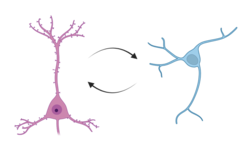Balance of neurons in the brain changes with age
The brain is a complex network of neurons that communicate with each other in circuits embedded in the structural scaffolding of the brain. There are two main types of neurons: excitatory neurons, which transmit information by amplifying neural signals, and inhibitory neurons, which can suppress the signals. Together, excitation and inhibition maintain a carefully tuned balance, known as the excitation-inhibition (E-I) balance, which is essential for healthy brain function. But the level of this balance is suggested to differ between individuals, become impaired in disorders, and mature throughout development. In their new paper in the journal Science Advances, Amin Saberi and Sofie Valk from MPI CBS together with Simon Eickhoff from Research Centre Jülich focused on this balance within neuronal circuits, and used computer simulations of individualized brain models to study its change with age during adolescence.

Amin Saberi, first author of the study, explains the background of the study: “As the human brain matures during development we wanted to know how the interactions between excitatory and inhibitory neurons changes. This has been shown in animal studies but it is difficult to show it in humans because it is not easily possible to record activity directly from the neurons there, so we used computer simulations run on supercomputers. For the first time, they were created individually for each of the 900 participants in different ages we had in the study. It was important for us to look at the balance between the excitatory and inhibitory neurons and its maturation in the healthy brain because it is thought to support human cognitive processing and development, and be altered in neurodevelopmental and neuropsychiatric conditions such as schizophrenia and autism.”
Sofie Valk, group leader at MPI CBS, sums up the results: “Overall, in this study we observed evidence suggesting a replicable and robust increase of regional inhibition in association areas during adolescence. The maturation of the balance between excitation and inhibition is suggested to have important functional consequences and if it's disturbed we believe it is associated with various neurodevelopmental disorders. For example, the neurodevelopmental model of schizophrenia suggests that aberrant cortical maturation, importantly in the development of those neuron balanced functions, may contribute to the emergence of the disease later in life. On the other hand, excitatory and inhibitory processes per se are important foundations for human cognition and its development. Future studies should investigate the clinical relevance of adolescent maturation of this balance in association with the risk and diagnosis of neurodevelopmental disorders such as schizophrenia, potentially offering biomarkers for early detection and intervention.”












